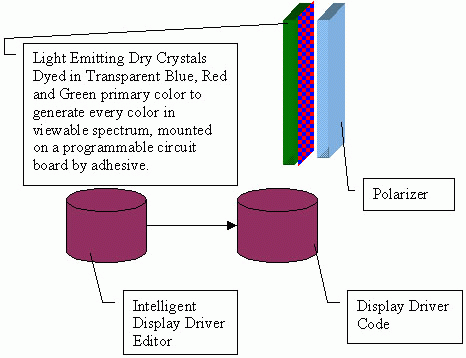|
|
|
|||||||||||||
|
|
|||||||||||||
Touchtop Technologies, Inc. |
||||||||||
THE PRODUCT/THE TECHNOLOGY Cathode Ray Tube display is the highest resolution display
device available today. The portability of this technology is an unfortunate limitation imposed by the picture tube. This dilemma led to the design and development of the Liquid Crystal Display (LCD).
Traditional, passive matrix LCD systems are essentially a combination of a wire grid, a light source, polarizers and a liquid crystal solution. Liquid Crystal Elements control the emission or omission of light
passage, which creates a viewable image. A key limitation of passive LCD systems is their inability to produce images that can be viewed from all angles. To combat this problem, the Active Matrix Liquid
Crystal Display (AMLCD) was invented. Active Matrix LCD's produce viewable images in the same manner as Passive Matrix LCD's with one added, and very expensive, component: Thin Film
Transistors (TFT's). A transistor controls each and every pixel in the display. This allows the display to generate high-resolution images that are viewable from more angles. There are two limiting
factors that drive the search for alternatives to AMLCD's. First, the cost of manufacturing these displays is higher than that of nearly every competing technology. Secondly, there are size constraints that
limit production of very large displays, those exceeding 16" diagonal screens. TouchTop Technologies' Dry Crystal Display System overcomes these limitations with breakthrough proprietary technology.
At the heart of TouchTop's Light Emitting Dry Crystal Display (LEDCD) is, as one might suspect, dry crystal elements. These synthetic elements, when electrically charged, emit light. Because the elements are
transparent in their untreated state, applying TouchTop's patented Dry Crystal Dye® creates a light source that produces vivid colors. These dyed elements are mounted to a controllable circuit
board by an adhesive. Precisely placing each element, dyed in one of the three primary colors, would involve the construction of complex manufacturing equipment. This was the major obstacle that prevented
Dr. Chenenko from producing the display years ago. To combat this threat to the commercial feasibility of the system, Mr. Patel constructed an intelligent software program that estimates the distribution of red,
blue and green elements and edits the video driver code appropriately. The end result is a visual display that literally blows away competing technologies. A diagram of how the system works
follow:
|
||||||||||
The Enterprise 6. |
||||||||||
Contact Webmaster@cbulletproofbizplans.com
with comments or questions regarding this site. |
||||||||||

